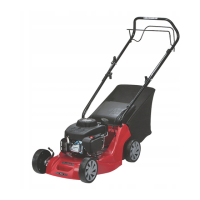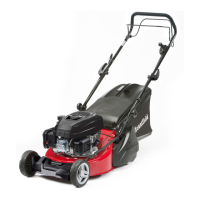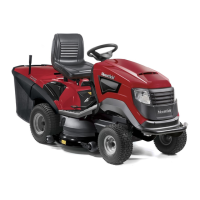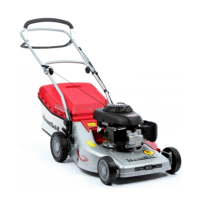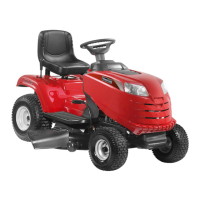10
ENGLISH
GB
4. Set the throttle control B in the choke posi-
tion . NOTE! It is not necessary to use the
choke position when the engine is warm (fig.
12).
5. Press the Start/Stop loop G towards the handle.
NOTE! The Start/Stop loop G must be kept
pressed in to prevent the engine stopping (fig.
12).
6. Grasp the starter handle and start the engine by
pulling briskly on the starter cord.
7. When the engine starts, move the throttle con-
trol backwards until max. revs are obtained.
NOTE! The engine should always be run at
maximum revs to avoid abnormal machine vi-
brations.
Keep hands and feet away from the ro-
tating blade(s). Never put your hand or
foot under the blade casing or in the
grass ejector while the engine is run-
ning.
STOPPING THE ENGINE
The engine may be very warm immedi-
ately after it is shut off. Do not touch the
silencer, cylinder or cooling flanges.
This can cause burn injuries.
1. Release the Start/Stop loop G (fig. 12) to stop
the engine. This loop must not be disengaged
(e.g. by setting it in the depressed position
against the handle), as it will not be possible to
stop the engine.
Honda: Close the fuel tap.
2. If the lawnmower is left unattended, remove the
spark plug cable from the spark plug.
If the start/stop loop ceases to work, stop
the engine by removing the spark plug
cable from the spark plug. Immediately
take the lawn mower to an authorised
workshop for repair.
REAR WHEEL DRIVE (*)
Engage the drive by pressing the clutch loop I to-
wards the handle. Disengage the drive by releasing
the clutch loop I (fig. 12).
CUTTING HEIGHT
Shut off the engine before adjusting the
cutting height.
Do not set the cutting height so low that
the blade come into contact with uneven
ground.
The mower has single-lever control for adjusting
the cutting height. Pull the lever out, and set the
cutting height to one of the nine positions best suit-
ed to your lawn (fig. 13).
MAINTENANCE
No servicing may be carried out on the
engine or lawnmower without first re-
moving the spark plug cable from the
spark plug.
Stop the engine and remove the spark
plug cable if the mower is to be lifted,
e.g. during transportation.
If the lawnmower needs to be tilted, it
must be tilted so that the engine’s spark
plug faces upwards. Tilt the lawnmower
when the fuel tank is empty.
CLEANING
After each use the mower should be cleaned. This
is particularly important on the underside of the
mower casing. Rinse clean with the garden hose.
The mower will then last longer and work better.
High-pressure washers should not be used.
If grass has dried on to the mower casing, it can be
scraped clean. If necessary, touch up the underside
with paint to prevent rust damage.
Clean the silencer and the surrounding
area regularly to remove grass, dirt and
flammable waste products.
Remove the transmission cover by removing the
screws S (fig. 20) and clean around the transmis-
sion (*) and drive belts (*) with a brush or com-
pressed air once or twice a year.
Once every season, the drive wheels (*) should be
cleaned internally. Remove both wheels. Clean the
gear wheel and the wheel gear rim of grass and dirt
using a brush or compressed air (fig. 14). Replace
the wheel.

